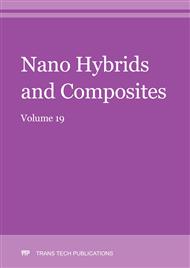[1]
Beaudoin, J., Feldman, R. F., The flow of helium into the microspaces of magnesium oxysulfate cement paste,, Cement and Concrete Research, 7, 1977, pp.585-596.
DOI: 10.1016/0008-8846(77)90120-x
Google Scholar
[2]
Beaudoin, J., Ramachandran, V. S., Strength development in magnesium oxysulfate cement,, Cement and Concrete Research, 8, 1978, pp.103-112.
DOI: 10.1016/0008-8846(78)90063-7
Google Scholar
[3]
Davies, P. J., Bubela, B. 1973, The transformation of nesquehonite into hydromagnesite,, Chemical Geology, 12, 289-300.
DOI: 10.1016/0009-2541(73)90006-5
Google Scholar
[4]
Flatt, R. J., Roussel, N. et al., Concrete: An eco material that needs to be improved,, Journal of the European Ceramic Society, 32, 2012, pp.2787-2798.
DOI: 10.1016/j.jeurceramsoc.2011.11.012
Google Scholar
[5]
Gao, P.-W., Xu, S.-Y. et al., Research on autogenous volume deformation of concrete with MgO,, Construction and Building Materials, 2013, 40, pp.998-1001.
DOI: 10.1016/j.conbuildmat.2012.11.025
Google Scholar
[6]
Gao, P., Lu, X. et al, Production of MgO-type expansive agent in dam concrete by use of industrial by-products,, Building and Environment, 43, 2008, pp.453-457.
DOI: 10.1016/j.buildenv.2007.01.037
Google Scholar
[7]
Harrison, J. W., TecEco Eco-Cement masonry product update – Carbonation=Sequestration,, (2005).
Google Scholar
[8]
Könisberger, E., Könisberger, L.-C. et al., Low-temperature thermodynamic model for the system Na2CO3-MgCO3-CaCO3-H2O,, Geochimica et Cosmochimica Acta, 63, 1999, pp.3105-3119.
DOI: 10.1016/s0016-7037(99)00238-0
Google Scholar
[9]
Kırgız, M.S., Fresh and Hardened Properties of Green Binder Concrete Containing Marble Powder and Brick Powder,, European Journal of Environmental and Civil Engineering, Issue Sup1: Supplement: Green Binder Materials for Civil Engineering and Architecture Applications, 20, 2016a, pp.64-101.
DOI: 10.1080/19648189.2016.1246692
Google Scholar
[10]
Kırgız, M.S., Strength Gain Mechanism for Green Mortar Substituted Marble Powder and Brick Powder for Portland Cement,, European Journal of Environmental and Civil Engineering, Issue Sup1: Supplement: Green Binder Materials for Civil Engineering and Architecture Applications, 20, 2016b, pp.38-63.
DOI: 10.1080/19648189.2016.1246691
Google Scholar
[11]
Kırgız, M.S., Use of ultrafine marble and brick particles as raw materials in cement manufacturing,, Materials and Structures, 48(9), 2015a, p.2929–2941.
DOI: 10.1617/s11527-014-0368-6
Google Scholar
[12]
Kırgız, M.S., Advances in physical properties of C class fly ash–cement systems blended nanographite (Part 2),, ZKG International, 1-2, 2015b, p.60–67.
Google Scholar
[13]
Kırgız, M.S., Supernatant Nanographite Solution for Advance Treatment of C Class Fly Ash–Cement Systems (Part 2),, ZKG International, 5, 2015c, p.42–47.
Google Scholar
[14]
Kırgız, M.S., Supernatant Nanographite Solution for Advance Treatment of C Class Fly Ash–Cement Systems (Part 1),, ZKG International, 4, 2015d, p.56–65.
Google Scholar
[15]
Kırgız, M.S., Advancements in Mechanical and Physical Properties for Marble Powder–Cement Composites Strengthened by Nanostructured Graphite Particles,, Mechanics of Materials, 92(1), 2016c, p.223–234.
DOI: 10.1016/j.mechmat.2015.09.013
Google Scholar
[16]
Kırgız, M.S., Advance Treatment by Nanographite for Portland Pulverised Fly Ash Cement (The class F) Systems,, Composites Part B, 82(12), 2015e, p.59–71.
DOI: 10.1016/j.compositesb.2015.08.003
Google Scholar
[17]
Kırgız, M.S., Strength Gain Mechanisms of Blended-Cements Containing Marble Powder and Brick Powder,, KSCE Journal of Civil Engineering, 19(1), 2015f, p.165–172.
DOI: 10.1007/s12205-014-0557-4
Google Scholar
[18]
Kırgız, M. S., Chemical properties of blended cement pastes,, Journal of Construction Engineering and Management, 137(12), 2011, p.1036–1042.
Google Scholar
[19]
Liska, M., Al-Tabbaa A., Ultra-green construction: reactive magnesia masonry products,, Proceedings of the ICE - Waste and Resource Management, 162, 2009, pp.185-196.
DOI: 10.1680/warm.2009.162.4.185
Google Scholar
[20]
Liska, M., Al-Tabbaa A. et al., Scaled-up commercial production of reactive magnesia cement pressed masonry units. Part I: Production,, Proceedings of the ICE - Construction Materials, 165, 2013a, pp.211-223.
DOI: 10.1680/coma.10.00032
Google Scholar
[21]
Liska, M., Al-Tabbaa A. et al., Scaled-up commercial production of reactive magnesia cement pressed masonry units. Part II: Performance,, Proceedings of the ICE - Construction Materials, 165, 2013b, pp.225-243.
DOI: 10.1680/coma.10.00031
Google Scholar
[22]
Marini, L., Geological Sequestration of Carbon Dioxide. Thermodynamics, kinetics and reaction path modelling,, Elsevier 2007, Oxford.
Google Scholar
[23]
Mestres, G., Ginebra, M.-P., Novel magnesium phosphate cements with high early strength and antibacterial properties,, Acta Biomaterialia, 7, 2011, pp.1853-1861.
DOI: 10.1016/j.actbio.2010.12.008
Google Scholar
[24]
Mo, L., Deng, M. et al., Effects of calcination condition on expansion property of MgO-type expansive agent used in cement-based materials,, Cement and Concrete Research, 40, 2010, pp.437-446.
DOI: 10.1016/j.cemconres.2009.09.025
Google Scholar
[25]
Shand, M. A., The chemistry and technology of magnesia,, John Wiley and Sons, (2006).
Google Scholar
[26]
Sorrell, C. A., Armstrong, C. R., Reactions and equilibria in magnesium oxychoride cements,, Journal of the American Ceramic Society, 59, 1976, pp.51-54.
Google Scholar
[27]
Unluer, C., Al-Tabbaa, A. Impact of hydrated magnesium carbonate additives on the carbonation of reactive MgO cements,, Cement and Concrete Research, 54, 2013, pp.87-97.
DOI: 10.1016/j.cemconres.2013.08.009
Google Scholar
[28]
Unluer, C., Al-Tabbaa, A. Enhancing the carbonation of MgO cement porous blocks through improved curing conditions,, Cement and Concrete Research, 59, 2014, pp.55-65.
DOI: 10.1016/j.cemconres.2014.02.005
Google Scholar
[29]
Urwongse, L., Sorrell, C. A., The System MgO-MgCl2-H2O at 23°C,, Journal of the American Ceramic Society, 63, 1980, pp.501-504.
DOI: 10.1111/j.1151-2916.1980.tb10752.x
Google Scholar
[30]
Vandeperre, L., Liska M. et al., Microstructures of reactive magnesia cement blends,, Cement and Concrete Composites, 30, 2008, pp.706-714.
DOI: 10.1016/j.cemconcomp.2008.05.002
Google Scholar
[31]
Viani, A., Gualtieri, A. F., Preparation of magnesium phosphate cement by recycling the product of thermal transformation of asbestos containing wastes,, Cement and Concrete Research, 58, 2014, pp.56-66.
DOI: 10.1016/j.cemconres.2013.11.016
Google Scholar
[32]
Wesolowski, M., Thermal decomposition of talc: A review,, Thermochimica Acta, 78, 1984, pp.395-421.
DOI: 10.1016/0040-6031(84)87165-8
Google Scholar
[33]
Xiong, Y., Lord, A. S., Experimental investigations of the reaction path in the MgO-CO2-H2O system in solutions with various ionic strengths, and their applications to nuclear waste isolation,, Applied Geochemistry, 23, 2008, pp.1634-1659.
DOI: 10.1016/j.apgeochem.2007.12.035
Google Scholar
[34]
Yi, Y., Liska, M. et al., Initial investigation into the use of GGBS-MgO in soil stabilization,, 4th International Conference on Grouting and Deep Mixing. Reston, VA, ASCE, (2012).
DOI: 10.1061/9780784412350.0030
Google Scholar


